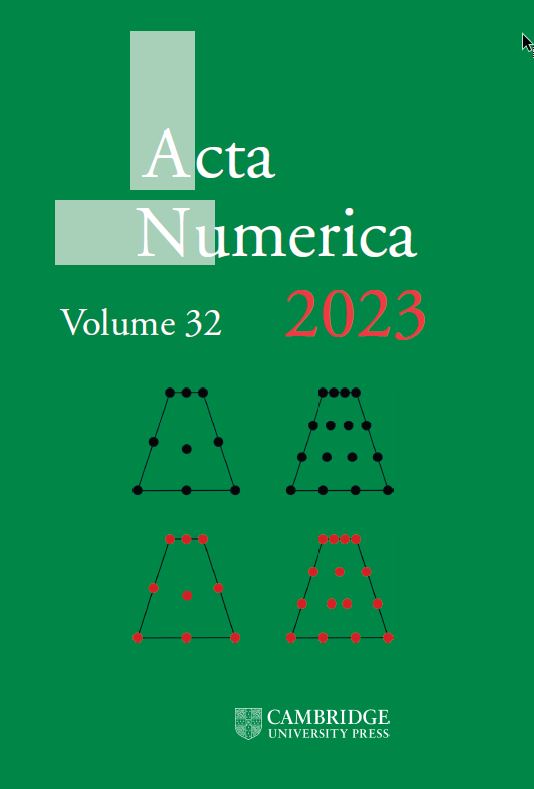施瓦兹方法的域截断
IF 11.3
1区 数学
Q1 MATHEMATICS
引用次数: 5
摘要
Schwarz方法使用将计算域分解为子域,并且需要在子域边界上施加边界条件。在域截断中,将无界域限制为有界计算域,并且必须在计算域边界上设置边界条件。在这两个领域都有大量的文献,研究也非常活跃和持续。将Schwarz方法中的域分解视为域到子域的截断,这是富有成效的。Hagstrom、Tewarson和Jazzilevich(1988)、Després(1990)和Lions(1990)的论文是这一基本思想的先驱。Nataf(1993)提出了第一个在有限步数内收敛的真正最优的Schwarz方法,并使用精确透明的边界条件作为子域之间的传输条件。对这些透明边界条件进行近似以实现Schwarz方法的快速收敛,导致了优化Schwarz法的发展——这一名称在基于域截断的Schwarz算法中变得很常见。与使用简单狄利克雷传输条件并已成功应用于广泛应用的经典Schwarz方法相比,优化Schwarz法的理解要少得多,主要是因为它们的传输条件更复杂。Schwarz方法在如此复杂的传输条件下的一个关键应用是时间谐波传播问题,因为经典的Schwarz法在这种情况下根本不起作用。过去的十年给了我们许多基于域截断的新的Schwarz方法。一篇从算法角度的综述(Gander和Zhang 2019)表明,许多新方法与优化的Schwarz方法是等价的。然而,对优化的Schwarz方法的分析落后于它们的算法开发。一般的抽象Schwarz框架不能用于分析这些方法,因此关于它们的收敛性存在许多悬而未决的理论问题。正如实际的多重网格方法一样,傅立叶分析有助于理解优化Schwarz方法的收敛性,并调整其传输条件。与多重网格中的局部傅立叶模式分析类似,无界两子域情况由于其简单性而被用作优化Schwarz方法的傅立叶分析模型。因此,在无界双子域分析中,实际情况的许多方面,如原始问题的边界条件和子域的数量,都被忽略了。虽然这提供了重要的见解,但在无界的两个子域模型之外,发现了新的现象。这种现状是我们进行调查的动机:在考虑原始边界条件、许多子域分解和分层介质的情况下,对基于傅立叶分析的优化Schwarz方法的收敛性进行全面回顾和精确探索。我们将扩散情况$\eta>0$(屏蔽拉普拉斯方程)或振荡情况$\eta<0$(亥姆霍兹方程)中的算子$-\Delta+\eta$视为我们的模型问题,以显示Schwarz解算器对这些问题的行为的根本差异。我们研究的传输条件包括最低阶吸收条件(Robin),以及更先进的完全匹配层(PML),这两种条件都是首次为域截断而开发的。在过去的两年里,我们在这篇综述中进行了大量的工作,首次在这里提出了几个新的结果:在亥姆霍兹方程的有界两子域分析中,我们看到了施加在全局问题上的原始边界条件对Schwarz方法的收敛因子的强烈影响,并且具有小重叠的渐近收敛因子可以不同于无界两子域分析。在多子域分析中,我们发现了随着子域数量的缩放,例如,当子域大小固定时,自由空间波问题的双扫描Schwarz方法的鲁棒收敛性,无论是在固定重叠和零阶Taylor条件下,还是在对数增长的PML下,我们发现具有PML的Schwarz方法像平滑器一样工作,对于更高的傅立叶频率收敛更快;特别地,对于自由空间波问题,以直角通过界面的平面波(在误差中)收敛得更慢。除了我们在第2节和第3节中的主要重点分析外,我们在第1节中首先对Schwarz方法进行了历史性的介绍,在第4节中,我们从传输条件的角度简要解释了最近提出的用于带交叉点分解的最优Schwarz法。我们在第5节中总结了开放研究问题。本文章由计算机程序翻译,如有差异,请以英文原文为准。
Schwarz methods by domain truncation
Schwarz methods use a decomposition of the computational domain into subdomains and need to impose boundary conditions on the subdomain boundaries. In domain truncation one restricts the unbounded domain to a bounded computational domain and must also put boundary conditions on the computational domain boundaries. In both fields there are vast bodies of literature and research is very active and ongoing. It turns out to be fruitful to think of the domain decomposition in Schwarz methods as a truncation of the domain onto subdomains. Seminal precursors of this fundamental idea are papers by Hagstrom, Tewarson and Jazcilevich (1988), Després (1990) and Lions (1990). The first truly optimal Schwarz method that converges in a finite number of steps was proposed by Nataf (1993), and used precisely transparent boundary conditions as transmission conditions between subdomains. Approximating these transparent boundary conditions for fast convergence of Schwarz methods led to the development of optimized Schwarz methods – a name that has become common for Schwarz methods based on domain truncation. Compared to classical Schwarz methods, which use simple Dirichlet transmission conditions and have been successfully used in a wide range of applications, optimized Schwarz methods are much less well understood, mainly due to their more sophisticated transmission conditions. A key application of Schwarz methods with such sophisticated transmission conditions turned out to be time-harmonic wave propagation problems, because classical Schwarz methods simply do not work in this case. The past decade has given us many new Schwarz methods based on domain truncation. One review from an algorithmic perspective (Gander and Zhang 2019) showed the equivalence of many of these new methods to optimized Schwarz methods. The analysis of optimized Schwarz methods, however, is lagging behind their algorithmic development. The general abstract Schwarz framework cannot be used for the analysis of these methods, and thus there are many open theoretical questions about their convergence. Just as for practical multigrid methods, Fourier analysis has been instrumental for understanding the convergence of optimized Schwarz methods and for tuning their transmission conditions. Similar to local Fourier mode analysis in multigrid, the unbounded two-subdomain case is used as a model for Fourier analysis of optimized Schwarz methods due to its simplicity. Many aspects of the actual situation, e.g. boundary conditions of the original problem and the number of subdomains, were thus neglected in the unbounded two-subdomain analysis. While this gave important insight, new phenomena beyond the unbounded two-subdomain models were discovered. This present situation is the motivation for our survey: to give a comprehensive review and precise exploration of convergence behaviours of optimized Schwarz methods based on Fourier analysis, taking into account the original boundary conditions, many-subdomain decompositions and layered media. We consider as our model problem the operator
$-\Delta + \eta $
in the diffusive case
$\eta>0$
(screened Laplace equation) or the oscillatory case
$\eta <0$
(Helmholtz equation), in order to show the fundamental difference in behaviour of Schwarz solvers for these problems. The transmission conditions we study include the lowest-order absorbing conditions (Robin), and also more advanced perfectly matched layers (PMLs), both developed first for domain truncation. Our intensive work over the last two years on this review has led to several new results presented here for the first time: in the bounded two-subdomain analysis for the Helmholtz equation, we see strong influence of the original boundary conditions imposed on the global problem on the convergence factor of the Schwarz methods, and the asymptotic convergence factors with small overlap can differ from the unbounded two-subdomain analysis. In the many-subdomain analysis, we find the scaling with the number of subdomains, e.g. when the subdomain size is fixed, robust convergence of the double-sweep Schwarz method for the free-space wave problem, either with fixed overlap and zeroth-order Taylor conditions or with a logarithmically growing PML, and we find that Schwarz methods with PMLs work like smoothers that converge faster for higher Fourier frequencies; in particular, for the free-space wave problem, plane waves (in the error) passing through interfaces at a right angle converge more slowly. In addition to our main focus on analysis in Sections 2 and 3, we start in Section 1 with an expository historical introduction to Schwarz methods, and in Section 4 we give a brief interpretation of the recently proposed optimal Schwarz methods for decompositions with cross-points from the viewpoint of transmission conditions. We conclude in Section 5 with a summary of open research problems. In Appendix A we provide a Matlab program for a block LU form of an optimal Schwarz method with cross-points, and in Appendix B we give the Maple program for the two-subdomain Fourier analysis.
求助全文
通过发布文献求助,成功后即可免费获取论文全文。
去求助
来源期刊

Acta Numerica
MATHEMATICS-
CiteScore
26.00
自引率
0.70%
发文量
7
期刊介绍:
Acta Numerica stands as the preeminent mathematics journal, ranking highest in both Impact Factor and MCQ metrics. This annual journal features a collection of review articles that showcase survey papers authored by prominent researchers in numerical analysis, scientific computing, and computational mathematics. These papers deliver comprehensive overviews of recent advances, offering state-of-the-art techniques and analyses.
Encompassing the entirety of numerical analysis, the articles are crafted in an accessible style, catering to researchers at all levels and serving as valuable teaching aids for advanced instruction. The broad subject areas covered include computational methods in linear algebra, optimization, ordinary and partial differential equations, approximation theory, stochastic analysis, nonlinear dynamical systems, as well as the application of computational techniques in science and engineering. Acta Numerica also delves into the mathematical theory underpinning numerical methods, making it a versatile and authoritative resource in the field of mathematics.
 求助内容:
求助内容: 应助结果提醒方式:
应助结果提醒方式:


